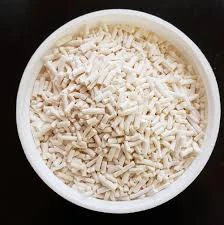
The Role of Aluminum Hydroxide in Managing Kidney Disease Effects and Treatments
Aluminum Hydroxide in the Management of Kidney Disease Uses, Risks, and Alternatives
Aluminum hydroxide has long been utilized in the medical field, particularly in treating conditions related to the gastrointestinal system, such as hyperacidity and peptic ulcers. However, in recent years, its role in the management of kidney disease has attracted attention, primarily due to its ability to bind phosphate in patients with renal failure. This article explores the uses, risks, and potential alternatives associated with aluminum hydroxide in the context of kidney disease.
Use in Kidney Disease Management
In patients with chronic kidney disease (CKD), the kidneys are unable to excrete phosphate effectively, leading to hyperphosphatemia. Elevated phosphate levels can result in serious complications, including cardiovascular disease and secondary hyperparathyroidism. Aluminum hydroxide serves as a phosphate binder, reducing phosphate absorption in the gastrointestinal tract. By doing so, it can help manage serum phosphate levels in patients on dialysis and those with advanced CKD.
The administration of aluminum hydroxide is relatively straightforward. Physicians typically recommend patients take the medication with meals to enhance binding efficacy. As a result, it can be an effective adjunctive treatment for managing phosphate levels and minimizing complications associated with kidney disease.
Risks Associated with Aluminum Hydroxide
Despite its benefits, aluminum hydroxide is not without risks. One significant concern is the potential for aluminum accumulation in the body, particularly in patients with impaired renal function. Over time, excessive aluminum exposure can lead to toxicity, resulting in various health issues, including osteomalacia, neurotoxicity, and anemia. Neurological effects may manifest as confusion, memory loss, or even encephalopathy in severe cases.
aluminum hydroxide for kidney disease

Furthermore, long-term use of aluminum hydroxide for phosphate binding has been associated with a decline in bone health. This is particularly relevant for patients with CKD, who may already be at risk for mineral and bone disorders. As a result, the use of aluminum hydroxide is often a short-term strategy, emphasizing the importance of monitoring and reevaluating treatment plans regularly.
Alternatives to Aluminum Hydroxide
Given the potential risks associated with aluminum hydroxide, healthcare providers often explore alternative phosphate binders. Options include calcium-based binders, such as calcium acetate and calcium carbonate, as well as non-calcium-based agents like sevelamer and lanthanum carbonate. These alternatives can effectively manage phosphate levels in patients with kidney disease without the same risks of aluminum accumulation.
Additionally, dietary management plays a crucial role in phosphate control. Patients are often advised to limit the intake of phosphorus-rich foods, such as dairy products, nuts, and certain meats. A registered dietitian specializing in renal nutrition can provide tailored dietary recommendations to complement pharmacological treatments.
Conclusion
Aluminum hydroxide has a vital role in managing phosphate levels in patients with kidney disease; however, its use comes with inherent risks that require careful consideration. Monitoring for potential aluminum toxicity is essential, particularly in individuals with impaired renal function. As more effective and safer alternatives become available, healthcare providers should weigh the benefits of aluminum hydroxide against its risks, ensuring that patients receive the best possible care. Ultimately, a multidisciplinary approach that includes medication, dietary management, and regular monitoring is crucial for optimal patient outcomes in the context of kidney disease.
-
Pure Sodium Dichloroisocyanurate Dihydrate | Powerful DisinfectantNewsAug.29,2025
-
Industrial Chemicals: Quality & Purity for Every IndustryNewsAug.28,2025
-
Nitrile Rubber Honoring Strict Production StandardsNewsAug.22,2025
-
Aspartame Ingredients Honoring Food Safety ValuesNewsAug.22,2025
-
Fertilizer for Balanced Plant NutritionNewsAug.22,2025
-
Cyanide Gold Processing with High Purity AdditivesNewsAug.22,2025
-
Formic Acid in Textile Dyeing ApplicationsNewsAug.22,2025
Hebei Tenger Chemical Technology Co., Ltd. focuses on the chemical industry and is committed to the export service of chemical raw materials.
-

view more DiethanolisopropanolamineIn the ever-growing field of chemical solutions, diethanolisopropanolamine (DEIPA) stands out as a versatile and important compound. Due to its unique chemical structure and properties, DEIPA is of interest to various industries including construction, personal care, and agriculture. -

view more TriisopropanolamineTriisopropanolamine (TIPA) alkanol amine substance, is a kind of alcohol amine compound with amino and alcohol hydroxyl, and because of its molecules contains both amino and hydroxyl. -

view more Tetramethyl Thiuram DisulfideTetramethyl thiuram disulfide, also known as TMTD, is a white to light-yellow powder with a distinct sulfur-like odor. It is soluble in organic solvents such as benzene, acetone, and ethyl acetate, making it highly versatile for use in different formulations. TMTD is known for its excellent vulcanization acceleration properties, which makes it a key ingredient in the production of rubber products. Additionally, it acts as an effective fungicide and bactericide, making it valuable in agricultural applications. Its high purity and stability ensure consistent performance, making it a preferred choice for manufacturers across various industries.





